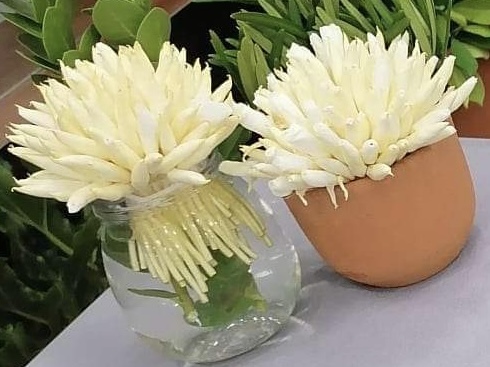
These buds from the herb plant Philippine Camia (Hedychium philippinense K. Schum) are valued for making garlands. An ongoing study in Lubao town in Pampanga province helps farmers find the appropriate technology to grow them as flowers and medicines. (Contributed photo)
CITY OF SAN FERNANDO, Pampanga — Researchers have lit solar lights around a 1,000-square-meter plot planted with Philippine Camia (Hedychium philippinense K. Schum) herbs in Lubao town in Pampanga province for a study on how best to grow the endangered plant for perfume and medicines.
The Don Honorio Ventura State University (DHVSU) research team led by Enmar Tuazon reported the recent progress of the study to Vice Gov. Lilia Pineda here on Monday.
Since she was mayor of Lubao in 1992, Pineda has supported rice farmers who had shifted to Sampaguita and other flowers or crops.
READ: Scent of success: Pampanga villagers find lifeline in sampaguita garlands
Tuazon said the study, “Sustainable Camia Flower Protection Using Telemonitored and Controlled Solar Power System,” is funded by the Department of Science and Technology through a P900,000 grant.
It aims to help farmers “determine the appropriate technology for growing camia,” he said, adding that when the research is completed in March, the results will be shared and taught.
The study site is located in Barangay Concepcion, where the camia flower is a primary cash crop. Around 30 hectares in several barangays in Lubao are grown to camia for flower garlands.
Local growers said that its production slumps during the northeast monsoon, locally known as amihan, from October to March when demands are high.
“We are monitoring factors like lighting, irrigation and soil,” Tuazon said.
READ: Sweet smell of success for ‘sampaguita’ growers
According to Tuazon, the study can be useful to those looking into the medicinal values of the plant. Citing a 2013 study by Verma and Bansal, the DHVSU team said camia is valued for its properties against diabetes, malaria, cancer, inflammation and indigestion.
“The Camia is not well studied, unlike the Sampaguita,” he said.
The Philippine Endangered website cited Camia as an endangered plant species. INQ

